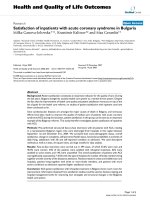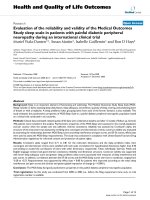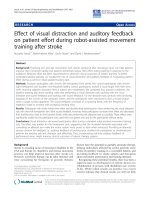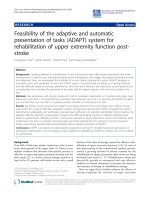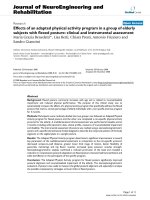Báo cáo hóa học: " Investigation of Nucleation Mechanism and Tapering Observed in ZnO Nanowire Growth by Carbothermal Reduction Technique" ppt
Bạn đang xem bản rút gọn của tài liệu. Xem và tải ngay bản đầy đủ của tài liệu tại đây (723.37 KB, 9 trang )
NANO EXPRESS Open Access
Investigation of Nucleation Mechanism and
Tapering Observed in ZnO Nanowire Growth
by Carbothermal Reduction Technique
Ayan Kar
1*
, Ke-Bin Low
4
, Michael Oye
5
, Michael A Stroscio
1,2,3
, Mitra Dutta
1,2
, Alan Nicholls
4
, M Meyyappan
5
Abstract
ZnO nanowire nucleation mechanism and initial stages of nanowire growth using the carbothermal reduction
technique are studied confirming the involvement of the catalyst at the tip in the growth process. Role of the Au
catalyst is further confirmed when the tapering observed in the nanowires can be explained by the change in the
shape of the catalyst causing a variation of the contact area at the liquid–solid interface of the nanowires. The rate
of decrease in nanowire diameter with length on the average is found to be 0.36 nm/s and this rate is larger near
the base. Variation in the ZnO nanowire diameter with length is further explained on the basis of the rate at which
Zn atoms are supplied as well as the droplet stability at the high flow rates and temperature. Further, saw-tooth
faceting is noticed in tapered nanowires, and the formation is analyzed crystallographically.
Introduction
Interest in nanowires continues to grow fueled by appli-
cations in electronics, optoelectronics, sensors, piezo-
electric and thermoelectric devices, and energy storage
[1]. In spite of considerable advances in growth and
application development of nanowires, the various pro-
posed growth mechanisms are still controversial and
subject to immense discussion. For example, it is well
documented that the diameter of nanowires grown via
the vapor–liquid–solid (VLS) mechanism is determined
by the size of the droplet. This is true but it does not
necessaril y imply that the diamet er of nanowires is con-
stant along its a xis. It has been recently reported that
the dynamic reshaping of the catalyst particles during
the nanowire growth determines the length and shape
of the nanowires [2]. Also, just as in elemental semicon-
ductors [3], there is a general consensus that even for
oxide nanowires the whole molten alloy particle,
referred to as the catalyst, rises above the surface of the
substrate and rides at the tip of the nanowire during the
growth process. The objective of this paper is twofold.
First, we investigate the initial stages of nucleation, oxi-
dation of Zn atoms, and growth of ZnO nanowires.
Secondly, we investigate the formation of tapered nano-
wires from the growth kinetics point of view. Compared
to elemental and III–V nanowires, growth behavior of
semi cond ucting oxide nanowires, and in particular ZnO
is not well understood [1]. ZnO has been proven to be
quite a complex and interesting material with a variety
of structures such as nanowires, nanobelts, and tetra-
pods [4]. Each of these struct ures can be formed by dif-
ferent growth mechanisms under widely different
thermodynamic conditions. The recent surge in applica-
tions of ZnO nanowires as a piezoelectric material [5]
for energy harvesting has led to the present investiga-
tion. The dependence of na nowire diameter on the
amount of generated piezoelectricity requires clarifica-
tion of the role of gold at the nanowire tip in control-
ling the shape and diameter of the nanowire [6].
Experimental Work
The source consists of zinc oxide (ZnO) metal basis of
99.999% purity mixed with graphite in a weight ratio of
1:1 to carry out a carbothermal reduction process. A 1″
diameter quartz tube was i nserted inside an isothermal
furnace, and the source mixture was kept in a quartz
boat inside this tubular reactor. Gold colloids were used
as the catalyst for different e xperiment s. The substrate
with the Au catalyst was placed downstream from the
quartz boat located at the center of the heating zone.
* Correspondence:
1
Electrical and Computer Engineering Department, University of Illinois,
Chicago, IL 60607, USA.
Full list of author information is available at the end of the article
Kar et al. Nanoscale Res Lett 2011, 6:3
/>© 2010 Kar et al. This is an Open Access article distributed under the terms of the Creative Commons Attribution License
( 2.0), which permits unrestricted use, distribut ion, and reproduction in any medium,
provided the original work is properly cited.
Oneendofthequartztubewasconnectedtoamass
flow controller, which controls the flow rate of the car-
rier gas, argon, and the other end was connected to the
exhaust. Nanowires were grown within a t emperature
window of 900–980°C, wherea s the carrier gas flow rate
was varied between 100–160 sccm.
Fif ty nanometres Au colloids (BBI International) were
used as the starting catalyst. The c-sapphire substrate
was treated with poly-L-Lysine before dropcasting the
Au colloidal solution. The substrate was then spun at
2000 rpm for 1.5–2 min ensuring a random dispersion
of the gold particles. The flow rate of Ar carrying the
Zn vapor was maintained at 100 sccm and turned on
only for the duration of growth after the temperature
was allowed to stabilize at 900°C. At the synthesis tem-
perature, carbothermal reduction of the ZnO powder
yields Zn vapor according to the following reactions:
Carbothermal Reduction source
ZnO C Zn CO
()
+→ +
:
() () () ()ss v g
(1)
Catalystalloy formation Zn Au Au Zn:() () ()vs l+→−
(2)
Results and Discussion
Figur e 1a shows the SEM image of the substrate surface
aft er the gold nanoparticles were exposed to the ZnO:C
source at 900°C for t = 90 ± 10 s. In the initial stages of
temperature ramping, the substrate b ecomes covered
with Au islands, which become the preferential sites for
Zn incorporation. The Zn atoms can either condense
from the vapor phase or be transferred from adjacent
regions of the substrate. Then, they rapidly diffuse into
the Au clusters forming the Au–Zn clusters. The Zn
concentration in these particles increases with time,
until a solid crystal nucleates out of the alloy droplet
due to supersaturation in the droplet. SEM-EDX was
performed in order to investigate t he islands seen in
Figure 1a, b and to gain further insight about the
nucleus formation. Figure 2a shows a SEM image of the
substrate surface after t = 90 ± 10 s. The EDS measure-
ment was performed on points A and B of the island in
Figure 2a, and the acquisition time was 120 s. The
major signals from EDS are O (Ka)at0.524keV,Au
(Ma)at2.1keV,andZn(La)at3.4keVusinga20kV
electron beam. The data obtained shows that the island
(point A) has a greater concentration of Zn compared
to Au. With increasing amount of Zn condensation and
dissolution from the source vapor, Zn and Au form an
alloy and liquefy giving rise to the islands on the sub-
strate. This leads to an increase in the volume of the
alloy droplet as more Zn is carried to the droplet and
dissolves. The process of Zn dissolution into the alloy
continues till the ratio of Zn in the Au– Zn alloy
increases beyond a certain thermodynamic limit, leading
to the formation of the nucleus. In contrast to the
islands, the nucleus has more Au compared to Zn as in
the EDX for point B. This is further confirmed by the
STEM-XEDS elemental mapping of a single ZnO wire
(see Figure 2d), which shows a high Au concentration
(yellow) in the catalyst at the tip of the nanowire. As Zn
continues to further condense/dissol ve into the nucleus,
precipitation of the ZnO nanowire would start under-
neath this nucleus with Au-dominated nucleus riding on
top of the nanowire as cataly st. Hence, the Au/Zn ratio
is found to vary from the islands remaining on the sub-
strate to the nucleus that becomes the catalyst riding on
top of the wire.
Formation of a crystal nucleus from the liquid Zn–Au
metal droplet (schematic of which is shown later in
Figure 4a) leading to nanowire growth is shown in two
stages in Figure 1b, c for t =90±10and120±10s,
respectively. Thermodynamically, Gibbs free ene rgy
minimization is the criterion to be satisfied for the for-
mation of the nucleus. After the nucleus is formed, ZnO
nanowires start to form, as shown in Figure 1d, e for t =
18 ± 1 min an d 20 ± 0.5 min, respectively, with the cat-
alyst at the tip which acts as the sink f or the Zn atoms
and generates a concentration gradient along the cata-
lyst particle. However, the Zn–Au alloy droplet on
which the nuclei forms remains on the s ubstrate. The
nanowire formation can be described by the following
reaction
Nanowire growth: Au Zn Zn O
Au Zn ZnO
−+ +
→− +
() ( ) /
() ( )
lv
ls
12
2
(3)
The oxidation process of the Zn leading to the forma-
tion of ZnO contributing to the nanowire growth is a
critical step. In the present case, it is likely that ZnO
nanowires originate from the oxida tion of the Zn atoms
within the Au–Zn alloy particle since it is commonly
known that the activity of metals can be increas ed upon
alloying. It has been previously reported that the oxida-
tion of alloys such as Zn–Ag and Zn–Cu results in the
formation of ZnO crystalline precipitates [7]. In a simi-
lar manner, it is believed ZnO will precipitate in the
form of ZnO nanowires due to the oxidation of Au–Zn
particles. There have also been recen t claims stating
that ther e is no involvement of a liquid or solid catalyst
at the tip of ZnO nanowires in the growth process
involving thermal evaporation [8]. The SEM images in
Figures 1d, e and 2d here show a distinct catalyst at the
nanowire tip that serves to contr ol the diameter of the
nanowire.
WeproposeherethatZnatomsarethemainspecies
contributing to crystal growth and not ZnO. The gold
Kar et al. Nanoscale Res Lett 2011, 6:3
/>Page 2 of 9
particles alloy with Zn and the oxide nanowires grow
with the assistance of the liquid catalyst particles at the
wire tip w here the Zn atoms are oxidized, as discussed
previously. Since the ZnO crystal nucleates at the solid–
liquid interface, the nanowire diameter is determined
and controlled by the size of the gold catalyst droplet at
the tip, which is a feature common in VLS process [1,9].
We also point out contradicting reports [10] wherein
nanowire branches with substantially different diameters
compared to the catalyst particle h ave been seen; a
growth mechanism different from VLS was suggested,
and ZnO atoms were believed to be the source of nano-
wire growth instead of Zn atoms.
The shape of the semiconductors at the nanoscale is
another decisive factor for the proper ties, and the shape
controlled growth of semiconductors can find unique
applications in electronics and photonics. Until now,
tapered ZnO nanowires hav e only been produced by
chemical synthesis or electrochemical deposition
method [11]. Here, we report the observation of tapered
ZnO nanowires grown using the carbothermal reduction
method in a furnace. Figure 3a shows nanowires with a
uniform diameter throughout their axis, grown on
p-type silicon substrates at a temperature of 900°C and
argon flow rate of 100 sccm. Tapered nanowires are
formed at a growth temperature of 980°C and an Ar
flow rate of 160 sccm as seen in Figure 3b–e. The
growthtimeswere10minforFigure3b,cand25min
for Figure 3d, e. At a lower flow rate of 140 sccm but
at the same temperature of 980°C, nanowires with just
a tapered base but uniform long stems are seen in
Figure 4b. The illustration in Figure 4a is used in order
to understand the tapering mechanism. To put things
into perspective, the growth of tapered nanowires can
be categorized as a special case of cylindrical nanowires
with the flank angle δ = 0. In fact, diameters of epitaxi-
ally grown Si nanowires have been shown [12] to vary,
especially in the region close to the substrate where the
Figure 1 a and b show the Au–Zn clusters with the nucleation sites formed on the substrates. c Early stage of nanowire nucleation from
the Au–Zn clusters. d and e show eventual wire formation with the presence of the catalyst at the nanowire tip (also shown as inset in fig e).
Scales in figure (a), (d), and (e) are 2 μm, whereas in figures (b) and (c), the scale is 500 nm and 200 nm, respectively.
Kar et al. Nanoscale Res Lett 2011, 6:3
/>Page 3 of 9
nanowires exhibit larger diameters just as seen here for
ZnO nanowires in Figures 3b–e and 4b. One first guess
would be that this large diameter is created by radial
overgrowth of the nanowire after axial growth. Espe-
cially at elevated temperatures, surface diffusion and
vapor–solid growth might influence the shape and result
in enlargement of the nanowire base. In particular, a
faceting of the nanowir e base expansion, often observ ed
at high temperatures, might occur after growth by
surface diffusion. Such faceting of the ba se is seen in
Figure 4b as indicated by arrows.
The illustration in Figure 4a shows that the decrease
in nanowire diameter along its length is controlled by
the size of the catalyst contact area at the liquid–solid
interface. In our case, the angle a equals to zero at the
beginning stages of nucleation. As growth begins, the
angle a has to increase, which is accompanied by an
increase in the contact angle b based on a modified
Young’s equation [12]:
lsls
R
cos( ) cos( )=−−
(4)
which means that the droplet approaches a larger solid
angle of spherical section. Here, s
l
, s
ls
,ands
s
are the
surface tension of the droplet surface, the liquid–so lid
interface, and the solid, respectively. The droplet at the
tip of the nanowire has a contact area of radius R and τ is
the line tension. The increase in the contact angle b
causes a decrease in the contact area and a decrease in
the radius R of the droplet. Consequently, the radius of
the nanowire R should be smaller than the initial radius
r′ of the contact area of the nuclei on the Au–Zn droplet.
Thus, the nanowire diameter is largest at the base and
decreases as the length of the wire increases, with the
diameter being directly controlled by the shrinking radius
of the contact area R at the droplet tip. The average rate
of decrease in the nanowire diameter with time (ta pering
rate) for needle-like nanowires here is estimated as
0.36 nm/s and plotted in Figure 4d. Also, plotted is the
growth rate of the nanowires, and the average rate
throughout the process is estimated as 3.9 nm/s. How-
ever, the growth rate is relatively slower at the onset o f
growth and speeds up with time. The decrease in dia-
meter of the nanowire with length of both needle-like
nanowires and the ones with just tapered bases are
plotted in F igure 4c. The rate of decrease in diameter is
much larger close to the base and then decreases as the
length increases. This can be explained by the fact that
therateofincreaseofanglea with length is large close
to the base of the nanowire and decreases gradually.
Thus, one reason for the decrease in n anowire diamet er
with length, i.e. tapering, is the reduction in the size of
the catalyst at the tip as growth progresses.
Figure 2 aSEMimageoftheAu–Zn nucleation sites formed on the substrates at early stages of growth. b an d c SEM-EDX done on
point A and point B as marked in figure (a). d shows STEM elemental spectral analysis done on an individual nanowire.
Kar et al. Nanoscale Res Lett 2011, 6:3
/>Page 4 of 9
Nanowires of two different morphologies are recalled
here: in one case, we have the tapering just restricted to
the base, as seen in Figure 4b, and another where we
see a continuous decrease in nanowire diameter with
length, as in Figure 3b–e; both morphologies can be
explained on the basis of the rate at which the Zn
atoms are deposited/delivered to the substrate if the
temperature is kept constant. The concentration of the
Zn adatoms at the substrate will increase as the Ar car-
rier gas flow rates are increased. Due to the concentra-
tion gradient between the substrate surface and the
nanowire, diffusion of the adatoms becomes prominent
at flow rates >140 sccm. Excess growth species are avail-
able at the base of the ZnO nanowire, where the mobi-
lity of Zn atoms diffusing from the substrate surface to
the nanowire tip is impeded and allows radial tapering
of the base [13]. The base diameter thus increases stea-
dily with an increase in flow rates. This gives rise
to tapered, as in Figure 4b, but not needle-shaped
nanowires, as in Figure 3. Further, it is to be noticed
that the tapered segment of the nanowire in Figure 4b is
very small. This is probably due to the limitation of ada-
tom diffusion via the nanowire sidewall, since the
upward adatom mobility via the nanowire sidewalls
decreases at high temperatures [14]. However, as the
flow rates are increased further, the tapered nanowires
give way to needle-like nanowires, obtained in this case
at a flow rate of 160 sccm as shown in Figure 3b–e
where there is a constant d ecrease in diameter with
length. Such observations have been reported previously
in the growth of InAs nanowires [13]. The tapering also
indicates that adatom surface diffusion from the sub-
strate up the nanowire sidewalls forms a path for the
growth species reaching the alloy droplet other than the
direct impingement of the atoms on the droplet, as has
been reported previously [13]. A theoretical study [15]
investigating the shape of the nanowires on the basis of
the contact angle b of the liquid droplet at the nanowire
Figure 3 a ZnO nanowires with uniform diameters grown on p-type Si (100) substrates. b–d show nanowires with a constant decrease in
diameter along the axis grown at a higher flow rate and temperature. The growth time for figures (b) and (c) were 10 min and that for figures
(e) and (f) were 25 min. Scales in all the figures are 2 μm.
Kar et al. Nanoscale Res Lett 2011, 6:3
/>Page 5 of 9
tip found surprisingly that tapered nanowire growth (∂ >0)
is more likely for a wide range of contact angles b com-
pared t o nanowires with uniform diameters.
The tapering of the nanowires can also be explained on
the basis of the stability and shape of the Au catalyst at
the tip of the nanowires. Nanowires with uniform dia-
meters, seen in Figures 1 and 3a, are formed when the
growth species land at a constant rate on the droplet, and
the droplet is sufficiently stable (when surface tension >
stress) at the growth temperature to resist decay or disin-
tegration and hence maintaining its spherical shape.
However,ithasbeennotedpreviously[16]thathigh
temperatures and flow rates cause droplet instability,
which may be one of the reasons for the continuous
decrease in nanowire diameter with length. Mohammad
reported [16] that high temperatures and flow rates cause
the Au particle at the tip of the nanowire to lose its sphe-
rical shape indicating an unstable droplet. This dro plet
instability leading to the formation of tapered nanowires
is clearly seen in Figure 5, which compares the shape of
the catalyst at the tip s of tapered (Figure 5a) and straight
(Figure 5b) nanowires. The catalyst at the tip of the
tapered nanowire has an ellipsoidal/triangular kind of
shape, whereas the straight nanowire still maintains a
hemispherical particle shape. It appears that the catalyst
in the tapered wire is elongated along the axial direction,
and it is not clear whether this elongation is an inter-
mediate state of the particle during the course of the
shrinking or if it represents some quasi-e quilibrium
shape at the experimental temperature and flow rate.
Figure 5c shows a representative straight wire with its
corresponding diffraction pattern, which also reveals a
zone axis of
2110
⎡
⎣
⎤
⎦
. The catalyst particle can also be
seen at the end of the wire, which is spherical in shape.
For the straight wire, the growth is in the [0001] direc-
tion, with both edges of the wires possibly bounded by
the
0110
()
plane. Figure 5d shows TEM images of the
straight and tapered wires where the straight wire is
found to be growing along the c-axis, whereas the tapered
wire along the
0110
⎡
⎣
⎤
⎦
direction.
Oversupply of source vapor as w ell as interplay of
surface energies of the wire and liquid droplet was also
reported to cause the droplet to be unstable, leading to
oscillations in resulting Si NW structures [17]. This is
Figure 4 a Schemati c of the nucleus formed on the molten Au–Zn droplet and ZnO nanowire growth at initial stages with tapering.
b ZnO nanowires with tapered base and uniform long stems. c Plot of nanowire diameter vs. length for both tapered and needle-like ZnO
nanowires. d Plot showing growth and tapering rates of needle-like ZnO nanowires.
Kar et al. Nanoscale Res Lett 2011, 6:3
/>Page 6 of 9
seen here in the case of the tapered ZnO wire in
Figure 5d, and such oscillations of the droplet resulting
in faceting in the nanowire sidewalls is discussed below
in detail. To our knowledge, this is the first observa-
tion of periodic saw-tooth faceting in ZnO nanowires;
the observed faceting is periodic, where the period P
of the facets is about 19.2 nm on average and the
height H is about 4 nm. Incidentally, such faceting is
observed only in tapered nanowires and not in straight
ones as seen in Figure 5d, indicating such faceting
mighthavesomerelationto the tapering mechanism
observed in our case.
Figur e 6a shows a tapered wire and its electron diffrac-
tion pattern, which indicates thatitismono-crystalline.
The zone axis of the diffraction pattern is the
2110
⎡
⎣
⎤
⎦
ofthehexagonalZnO.Thebaseofthesetaperedwires
varies greatly from half a micron to a few microns in size.
However, it is importa nt to stress that TEM observations
may not provide an accurate estimation of the wire
dimensions due to the nature of sample preparation.
Although the lateral sizes of these wires are in the sub-
micrometer scale, they still possess moderate degree of
electron transparency at low magnification, in dicating
that these wires have somewhat plate-like morphology.
In other words, t he widths of these wires are in the sub-
micron length scale; if the wires are hypothes ized to have
thicknesses similar to their widths, then there will be no
electron transparency even in a 300 kV TEM. Given that
atomic resolution was obser ved on these wires, the wire
thicknesses must be in the range of few tens of nan-
ometers, which means they are thin and wide (plate-like).
The tapered wire in Figure 6a reveals saw-toothed
morphology only on one of the edges, while the other
edge is atomically smooth. According to its diffraction
pattern, the smooth edge of the wire is running along
the
0110
⎡
⎣
⎤
⎦
direction,anditishypothesizedthatthis
Figure 5 TEM images of (a) tapered ZnO nanowires (b, c) nanowire with uniform diameter, inset in figure c shows diffraction pattern.
(d) TEM image of straight and tapered nanowires indicating the growth directions.
Kar et al. Nanoscale Res Lett 2011, 6:3
/>Page 7 of 9
edge is exposing the {0002} plane. High-resolution
images taken from another tapered wire Figure 6b con-
firms that the saw-toothed morphology is representative.
Figure 6b inset shows the location on the tapered wire
from which the high-resolution images were o btained.
Note that the catalyst particle (darker contrast) is still
intact on the tapered wire. Figure 6b shows that the
saw-toothed edge consists of two predominant types of
planes: the terraces, which are parallel to the smooth
edge, are exposing the (0002) plane; the steps, which
consistently make an angle of 62.3° (theoretical: 61.4°)
with the (0002), are exposing the
0110
()
plane. It is
important to note that strong lattice fringes are only
visible at the tapered, saw-toothed edge, suggesting that
the wire’ s cross-section is not uniform but actually
wedge-like, thinning toward the t apered, saw-toothed
edge. Based on the observed preferential exposure of the
{0002} and
0111
{}
-type planes in the hexagonal ZnO
crystal, a model in Figure 7 was constructed to describe
the growth of the tapered wire in relation with its crys-
tallographic orientation. We have seen that steps expos-
ing the
0111
()
plane help mitigate the tapering along
the edge of the wire. Given that there are other crystal-
lographically equivalent
0111
{}
planes in the hexago-
nal system, the model proposes that atomic-scale steps
should also exist on the top and bottom surfaces of the
wire. The possible step configurations are illustrated in
the diagram: (1) pure
1101
()
steps and (2)
1101
()
steps with (0002)/
0111
()
kinks. Indeed, the orienta-
tions of the ‘kinks’, indicated in Figure 6d, agree qualita-
tively with the proposed step configurations on the
surfaces of these wires.
One mechanism that could lead to such faceting is
surface reconstruction due to charge stabilization in
polar compounds. ZnO crystal is formed by alternating
stacks of oppositely charged O
2-
and Zn
2+
planes paral-
lel to the surface. If the resulting dipole moment per-
pendicular to the surface is nonzero, stabilization of
such a surface is accomplished by a rearrangement of
surface charges or by introducing compensating charges
into the outermost surface planes [18]. This could lead
a significant modification of the surface geometric struc-
ture and stoichiometry. The stabilization mechanism for
the Zn-terminated face of ZnO has been experimentally
investigated by a variety of techniques, and various
mechanisms have been proposed for the reduction in
the surface charge density to yield a stable Zn termina-
tion. Recent experimental studies [19] combined
with theo retical calculations [20] suggest that the
Zn-terminated surface can be stabilized by a reconstruc-
tion involving triangular surface structures [21]. How-
ever, due to the unstable nature of the catalyst at the
wire tip, it is believed here that faceting due to droplet
oscillation is the dominant mechanism that causes the
surface reconstructions. The observations seen here can
be explained based on a thermodynamic model used
earlier to explain similar faceting in Si nanowires [17].
The allowed facets correspond to a wire that is widening
or narrowing as it grows. The wire widens as the droplet
is stretched thinner and contact angle b (Figure 4a)
decreases, which generates an inward force favoring the
introduction of the narrowing facet. Conversely, the nar-
rowing of the wire leads to the droplet applying an
Figure 6 a and b shows TEM and HRTEM images of saw-toot h
faceting observed in tapered nanowires, respectively.
Kar et al. Nanoscale Res Lett 2011, 6:3
/>Page 8 of 9
increasing outward force on the wire, favoring an intro-
duction of the w idening facet. This oscillatory mechan-
ism leads to the periodic faceting seen here.
Concluding Remarks
In this investigation, using the carbothermal reduction
technique, ZnO nanowires are found to grow from nuclei
on the molten Au–Zn clusters. A tapering of diameter
along the axis is observed with the largest diameter at the
base. This may be due to the change in the contact angle
b of the catalyst droplet at the nanowire tip causing a
change in the contact area R at liquid–solid interface.
Thegrowthrateoftheneedle-likenanowiresisfoundto
be 3.9 nm/s and the tapering rate is established to be
0.36 nm/s on the average. Finally, the rate of addition of
Znatomsisfoundtocontrolthetaperingwherethe
tapering limited to the nanowire base gives way to a con-
tinuous taper along the nanowire length at higher deposi-
tion rates. The tapered wires are also found to have
uns table droplets at their tips, which are believed to be a
cause of tapering.
Acknowledgements
A.K would like to thank Dr. Shadi Dayeh and Dr. Ranadeep Bhowmick for
helpful discussions and suggestions. We thank Professor Sreeram Vaddiraju
for his insightful comments and help with the manuscript. Part of this work
was supported by the WCU-ITCE Program at Postech funded by the Korea
Science and Engineering Foundation from the Ministry of Education,
Science, and Technology.
Author details
1
Electrical and Computer Engineering Department, University of Illinois,
Chicago, IL 60607, USA.
2
Department of Physics, University of Illinois,
Chicago, IL 60607, USA.
3
Department of Bioengineering, University of Illinois,
Chicago, IL 60607, USA.
4
Research Resources Center, University of Illinois,
Chicago, IL 60607, USA.
5
Center for Nanotechnology, NASA Ames Research
Center, Moffett Field, CA 94035, USA.
Received: 20 June 2010 Accepted: 5 August 2010
Published: 19 August 2010
References
1. Meyyappan M, Sunkara MK: Inorganic Nanowires: Applications, Properties and
Characterization (Boca Raton, FL: CRC press); 2010, see Chapter 9 for Oxide
nanowires.
2. Hannon JB, Kodambaka S, Ross FM, Tromp RM: Nature Lett 2006, 440:69.
3. Wu Y, Yang P: J Am Chem Soc 2001, 123:3165.
4. Wang Z, Ma XY, Song JW, Yao JH: Nano-Micro Lett 2009, 1:45.
5. Wang ZL, Song J: Science 2006, 312:242.
6. Stan G, Ciobanu CV, Parthangal PM, Cook RF: Nano Lett 2007, 7:3691.
7. Vellinga WP, DeHosson JTM: Acta Mater 1997, 45:933.
8. Kim DS, Gosele U, Zacharias M: J Cryst Growth 2009, 311:3216.
9. Givargizov EI: J Cryst Growth 1975, 31:20.
10. Kim DS, Scholz R, Gosele U, Zacharias M: Small 2008, 4:1615.
11. Chang YC, Chen LJ: J Phys Chem C 2007, 111:1268.
12. Schmidt V, Senz S, Gosele U: Appl Phys A 2005, 80:445.
13. Dayeh SA, Yu ET, Wang D: Nano Lett 2007, 7:2486.
14. Reep DJ, Ghandhi SK: J Electrochem Soc 1984, 131:2697.
15. Nebol’sin VA, Shchetinin AA: Inorg Mater 39(203):899.
16. Mohammad SN: Nano Lett 2008, 8:1532.
17. Ross FM, Tersoff J, Reuter MC: Phys Rev Lett 2005, 95:146104.
18. Tasker PW: J Phys C 1979, 12:4977.
19. Diebold U, Koplitz LV, Dulub O: Appl Surf Sci 2004, 237:336.
20. Dulub O, Diebold U, Kresse G: Phys Rev Lett 2003, 90:016102.
21. Ostendorf F, Torbrugge S, Reichling M: Phys Rev B 2008, 77:041405R.
doi:10.1007/s11671-010-9738-3
Cite this article as: Kar et al.: Investigation of Nucleation Mechanism
and Tapering Observed in ZnO Nanowire Growth by Carbothermal
Reduction Technique. Nanoscale Res Lett 2011 6:3.
Figure 7 Model correlating the growth of tapered nanowire with saw-tooth faceting based on crystallography.
Kar et al. Nanoscale Res Lett 2011, 6:3
/>Page 9 of 9


